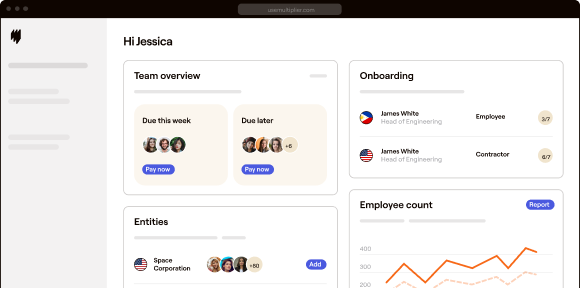The workplace is changing fast. Along with the changing nature of work and worker expectations, companies are also expanding internationally. To keep pace, the HR function needs to adapt.
Instead of focusing solely on domestic workforces, modern HR professionals need to understand and navigate the legal and cultural nuances of different countries. Gone are the days of a one-size-fits-all approach.
Global HR requires flexibility and a strong foundation in core HR practices. This includes everything from recruitment to talent management but with a global perspective. Even HR professionals in companies without international offices can benefit from a global mindset. Understanding workforce diversity and international business practices can make them more valuable assets.
With this in mind, we’ve delved deep and identified 10 key practices that can empower HR professionals to navigate the exciting and complex world of global HR.
1. Embrace cultural diversity
Valuing diversity within a workforce is no longer just a nicety; it’s a strategic advantage. Cultural diversity brings a delightful blend of perspectives to the table, fostering innovation and problem-solving beyond what a homogenous group could achieve.
A culturally diverse team also offers a richer understanding of international markets. Employees from various backgrounds provide insights that help companies connect with a broader customer base and navigate cultural nuances.
Ultimately, valuing diversity leads to smarter decisions, a more innovative work environment, and a stronger global brand.
HR’s role in championing diversity
- Build awareness: Weave cultural sensitivity into every interaction by crafting interview questions free from bias and designing onboarding programs that celebrate diverse backgrounds. Provide resources for employees to learn about different cultures.
- Bridge communication gaps: Train managers to recognize differences in communication styles, from understanding non-verbal cues to appreciating variations in formality at virtual meetings.
- Celebrate differences: Organize events that showcase cultural traditions, like potlucks or language exchange programs. This fosters a sense of belonging and allows employees to share their unique heritages.
- Accommodate needs: Go beyond celebrations to consider flexible work schedules for religious observances or culturally appropriate food options.
- Invest in training: Address unconscious bias, teach strategies for navigating cultural conflicts, and foster effective communication in multicultural teams through ongoing cultural competency training for both managers and employees.
By embracing diversity, HR professionals build a thriving global team. It’s about creating a welcoming environment where everyone feels valued, and their unique perspective is celebrated. This holds the key to unlocking a company’s true potential.
2. Ensure legal compliance
The world of work is a vibrant tapestry, woven with threads from diverse cultures. As businesses expand internationally, navigating the complexities of local and international labor laws becomes paramount. It’s not just about ticking boxes; it’s about fostering a thriving, respectful work environment for a global team.
The legal ramifications of non-compliance are severe. Financial penalties, lawsuits, and reputational damage can cripple a business. But the human cost is even greater. Cultural nuances can often go beyond written regulations and unhappy employees, subjected to unfair treatment, lead to decreased morale and productivity.
So how do we navigate this complex landscape? Partnering with legal experts like Multiplier is key. They provide invaluable insights into ever-evolving regulations, ensuring your policies are compliant and culturally sensitive.
Technology also plays a crucial role. Scheduling software can prevent overtime violations, while training modules can educate employees on their rights and responsibilities. Ultimately, ensuring legal compliance isn’t just about following the rules; it’s about building a strong foundation for a global team.
By prioritizing fair labor practices, you create a win-win situation – a happy, productive workforce and a business that thrives on a global stage.
3. Develop global communication strategies
The global landscape presents exciting opportunities but also brings with it a host of communication challenges. Language barriers and time zone differences can hinder collaboration and lead to misunderstandings. To bridge these gaps, an effective communication strategy is essential.
Communication tools: Allies for a connected world
Technology plays a critical role in overcoming communication barriers. Video conferencing platforms like Zoom or Microsoft Teams enable face-to-face interaction despite physical distance. Real-time translation features can bridge language gaps on the fly, fostering smoother interactions. Project management tools like Asana or Trello keep everyone on the same page, regardless of location.
Beyond the tech: Building relationships
But effective communication goes beyond just using the right tools. Building strong relationships and rapport within a team is key. Virtual team-building activities and informal social interactions can help team members connect on a personal level. This fosters trust and mutual understanding, leading to more effective communication even across time zones and languages.
By embracing an effective communication strategy and leveraging technology, you can bridge distances and language gaps, paving the way for successful collaboration.
4. Customize HR policies
Managing a team across borders is exciting, but a one-size-fits-all HR policy won’t work. Instead, consider these tips to customize your approach to empower your international team:
- Partner with experts: Employer of Record (EOR) experts like Multiplier can tackle legalities and payroll, freeing up your time to focus on employees.
- Craft a welcoming onboarding: Design an onboarding program that introduces new hires to your culture and values. Include diversity training to bridge cultural gaps.
- Embrace differences: Respect variations in communication styles and holidays. It’s about creating a global mindset, not a monoculture.
- Leverage technology: Distance shouldn’t hinder teamwork. Utilize video conferencing and project management tools to keep everyone connected. Adapt your tech policies to what works best for your team.
- Listen and learn: Hold virtual meetings to gather feedback. By incorporating employee voices, you can create inclusive and helpful policies.
A tailored HR policy shows your global team how you value their unique needs. This fosters a supportive environment leading to a more productive and engaged workforce.
The United States is lacking 340K accountants
Discover how 2K US companies are hiring accountants
5. Support employee relocation
Offering comprehensive relocation support is a win-win for both businesses and employees. It widens the talent pool for companies, allowing them to recruit the best person for the job regardless of location. This can be especially helpful for filling niche positions or expanding into new markets.
For employees, uprooting themselves can be daunting. Financial aid, logistical guidance, and cultural training show you care about their well-being. This translates to happier, more loyal employees, and fosters knowledge sharing across different locations. But, of course, relocation isn’t without challenges. Costs can add up, and some employees might be hesitant due to personal situations.
Here’s where a PEO like Multiplier can be a valuable asset. They handle all relocation complexities – visa applications, payroll, taxes – freeing you up to focus on your core business. This saves significant time and resources on both sides, making the entire process less stressful and more efficient.
6. Attract and retain global talent
In today’s competitive landscape, attracting and retaining top talent across borders is crucial for business success. Here are some key strategies to consider:
- Craft a magnetic employer brand: Showcase your company culture and values through engaging content and social media campaigns. Let potential hires see why yours is a great place to work!
- Embrace flexible working: The remote work revolution has opened the door to a global talent pool. Tailor your recruitment efforts to popular online job boards and social media platforms in target markets.
- Partner with talent acquisition experts: Leverage the experience of international recruitment firms to navigate local regulations, identify qualified candidates, and expedite the visa process.
- Nurture a culture of growth: Go beyond competitive salaries. Offer opportunities for professional development and upskilling to keep your team sharp and engaged.
- Prioritize diversity and inclusion: Build a workforce that reflects the global landscape. Fostering a culture that embraces different backgrounds and perspectives leads to a more creative and innovative team.
By implementing these strategies, you can attract high-performing individuals from around the world and build a thriving global team that propels your business forward.
Multiplier: Your streamlined global talent machine
Multiplier simplifies global talent acquisition by centralizing the entire process. Manage job postings, automate candidate screening, and facilitate communication across borders – all from one user-friendly platform. This streamlines workflows saves time and resources and empowers you to focus on building your global dream team.
7. Foster leadership development
Effective leadership hinges on fostering diverse teams. But simply assembling a varied group isn’t enough. Leadership development programs play a critical role in equipping managers with the skills to navigate these dynamics.
Such programs extend beyond traditional leadership principles. They delve into cultural competency and emotional intelligence, empowering leaders to recognize unconscious bias and promote fairness. Additionally, they focus on understanding diverse communication styles, fostering collaboration and leveraging the unique strengths of each team member.
Professional development is an ongoing process. By emphasizing adaptability and celebrating differences, leaders can cultivate a truly inclusive environment where everyone feels valued and empowered to contribute.
8. Adapt performance management
Performance evaluations are a cornerstone of any organization. But with a global workforce, it needs to be aligned based on the specificities of the cultures you serve.
Consider the following factors to understand if your performance management process if fit-for-purpose:
- Alignment with values: Adapt evaluation criteria to reflect the company’s evolving culture. If collaboration is key, teamwork and communication become crucial metrics. Communicate these changes clearly to your employees.
- Employee involvement: Involve employees in shaping the evaluation process. This fosters trust and a sense of ownership. Allow for self-evaluations, peer feedback, or culturally appropriate methods of gathering insights.
- Beyond numbers: Performance goes beyond metrics. Regular coaching and feedback, recognizing achievements, and offering support create a positive environment where employees feel valued.
By understanding cultural nuances and adapting practices, performance reviews become a bridge, not a barrier. They empower employees, strengthen company culture, and ultimately drive success.
9. Prioritize employee well-being
An overwhelmed employee struggling with workload, limited growth, and constant connection is a recipe for burnout. The solution is a global wellness program.
These programs delve deeper than perks or apps. They target stress at its source, focusing on leadership behaviors, work design, and flexible work styles. Leaders fostering empathy and psychological safety create a meaningful work environment with growth opportunities.
And the impact is undeniable. Reduced stress leads to happier, healthier, and more productive employees. This translates to a stronger employer brand, attracting and retaining top talent. Global wellness programs are a strategic investment in your company’s most valuable asset: its people.
10. Invest in continuous learning
The future of HR is all about agility and growth. HR professionals today face a rapidly changing landscape. But as new trends and best practices emerge constantly, it can all feel a bit overwhelming.
The answer lies in upskilling. Industry reports and online resources from experts can help identify in-demand global HR practices. Modern HR software can streamline tasks and free up time for learning. Conferences and workshops are great for networking and exchanging ideas with peers. LMS platforms, personalized learning paths, and mentorship programs all add up and build toward a culture of continuous learning!
Multiplier: Bringing strategy to life
Effective global HR goes beyond best practices. You’ll also need to tailor those practices to your company’s unique goals. And this demands an all-in-one digital tool that’s easy to customize and provides support across 150+ territories across the globe.
Multiplier can automate tasks and streamline workflows, empowering HR professionals to focus solely on strategic initiatives. It’s designed to handle cultural nuances and global compliance, making international employment, payroll, and compliance easy and risk-free!
Talk to our experts today to give shape to your dream HR strategy.







